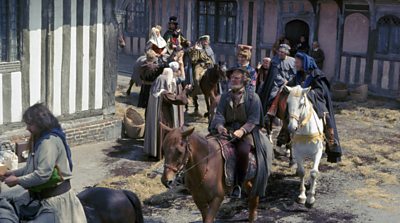
In any form of media, a role is carved out for the audience. It may be spelt out explicitly, as you often find in the introduction to a computer game. It may be implicit through our culture or enforced on the audience as with the silent, reverential audience in classical music concerts and established theatre. Most of the time, we pay no attention to our role as the audience; however, when a mismatch occurs between our expectations and the media, the importance of our role becomes apparent.
This mismatch between the audience's role and their expectation is a significant problem for most new forms of media and creates a barrier to success. Object-based media and other forms of interactive and personalised content are no exception. This work seeks to improve our understanding and the design of audience roles that work well for interactive and personalised content, and how that relates to developments in audience expectations in the era of social media.
The key thing to remember is the audience's role is an integral part of the media or performance. In the case of a book, the writer has to imagine the reader and relate them to the story. In his paper, , Walter J. Ong describes how the author creates the role of the audience through a frame story. In the earliest example, he shows how Chaucer casts the reader of Canterbury Tales as one of a group of pilgrims alongside the author, hearing oral stories told by each character.
Ong then describes how this approach evolved to the point where the frame story is taken for granted as part of the wider cultural framing, as is the case with the modern novel. With specialist genera, such as the crime novel, writers have even gone to the trouble of setting out to ensure that the reader has a fair chance of working out who committed the crime. The early crime novels were also known as puzzle books, making the reader's role more explicit.

When audiences enter a controlled space such as a theatre or concert hall, the role of the audience is often imposed. Around the beginning of the Victorian era, theatre audiences were gradually pacified and silenced, at first by staff and, more recently, by fellow audience members. This enforced, quiet passivity, along with the exclusion of the lower classes through increased ticket prices, led to a change in the types of play being written and the form of music being composed. In theatre, this gave rise to realism and naturalism; plays were set in domestic locations with sets consisting of three walls and the invention of the invisible 'fourth wall' cut the actors off from the audience.
The characters stopped acknowledging the presence of the audience, and the role of the audience became voyeuristic, looking in on the events, but playing no part in the performance. It is as if they are observing the neighbours through net curtains. The audience's passive, voyeuristic role has been inherited by cinema and television drama and even some documentaries. While this idea of a passive audience has been subverted by radical theatre and participatory cinema showings, alongside the survival of the interactive traditions of pantomime, the majority of mainstream drama retains the fourth wall.
Difficulties in framing audience roles become acute where technologies give rise to new forms of media. Often these new technologies are first used to reproduce existing forms of experience with awkward and unconvincing results. Concepts like making a 360° 'film' fail because of the mismatch between the old media and the latest technology. They also fail to take into account the way the new technology changes the role of the audience.
For example, in the case of a 360° experience in a headset, the narrative needs to be laid out spatially for the audience to explore, more like a garden design or museum than a rectangular film. In addition, almost all of the conventions of cinema editing must be discarded to avoid making the audience feel nauseous. The one workable approach is to reproduce a virtual cinema with a flat screen in a headset, which kind of misses the point.

Problems arise when the passive role is combined with audience interaction. The two directly conflict, especially if the audience is given agency over the narrative. In examples of interactive drama like Netflix's and ±«Óãtv Three's Our World War - High Wood, the audience has to switch between passive viewing and making active choices. This results in a loss of empathy with the main characters and an '' between roles. This has been confirmed in both cases by .
However, audiences now have different expectations of media and storytelling. Most people in the UK under 40 have grown up with mobile phones and ubiquitous connectivity. They now have expectations that include interactivity, with other audience members and the media. The rise of role-play games, followed by computer games, has also contributed to a cultural expectation that narrative is co-created with the players.
More recently, publishing platforms such as YouTube and streaming platforms like Twitch, along with the improved performance of smartphones, allow almost everyone to create and publish audio/visual media, often addressing the audience directly. This democratisation of media blurs the line between creator and consumer and alters the power balance between media companies and their audience. There has also been an adoption of domestic equipment for mainstream media production using mobile phones to shoot HDTV content, especially where this enables the telling of intimate and personal stories.

As a result of these changes in media technology and culture, the fourth wall separating the audience from the action is falling away. Recent TV series like Fleabag and This is Going to Hurt have main characters that directly address the audience, breaching the fourth wall to emotionally connect with the audience. This approach includes the audience in the story and makes way for interaction between the audience and the characters.
The interaction can take the form of a character consulting their invisible friend for advice or simply offering to guide the audience through a story as an oral storyteller might do. This has proved very successful with factual content like the ±«Óãtv's interactive magazine programme and the interactive trailer for for His Dark Materials, .
The role of the audience is continuing to evolve, and media companies need to keep up with these changes to stay relevant with younger audiences. In his 1999 essay , Douglas Adams described how young people were now using mobile phones to connect and predicted how that would change their perception of media:
"I expect that history will show 'normal' mainstream twentieth-century media to be the aberration in all this. 'Please, miss, you mean they could only just sit there and watch? They couldn't do anything? Didn't everybody feel terribly isolated or alienated or ignored?'"
This audience is now shaping mainstream culture marking a generational divide in media consumption. Media companies can no longer treat their audience as passive consumers and need to actively engage in forms of dialogue with them to remain relevant. Furthermore, now that people have access to many different sources of information, media companies need to be more transparent and show their working to retain the respect of a more media-literate audience.
- For a more in-depth analysis of this and many other issues, read our new White Paper, The Role of the Audience in Media: how culture, framing and narration give shape to the way stories are understood.
